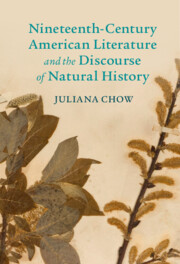Book contents
- Nineteenth-Century American Literature and the Discourse of Natural History
- Cambridge Studies in American Literature and Culture
- Nineteenth-Century American Literature and the Discourse of Natural History
- Copyright page
- Contents
- Figures
- Acknowledgments
- Introduction
- Chapter 1 Sketching American Species: Birds, Weeds, and Trees in Audubon, Cooper, and Pokagon
- Chapter 2 “Because I see—New Englandly—”: Emily Dickinson and the Specificity of Disjunction
- Chapter 3 Coral of Life: James McCune Smith and the Diasporic Structure of Racial Uplift
- Chapter 4 Thoreau’s Dispersion: Writing a Natural History of Casualties
- Afterword: &
- Notes
- Index
- Recent Books in This Series (continued from page ii)
Chapter 3 - Coral of Life: James McCune Smith and the Diasporic Structure of Racial Uplift
Published online by Cambridge University Press: 16 November 2021
- Nineteenth-Century American Literature and the Discourse of Natural History
- Cambridge Studies in American Literature and Culture
- Nineteenth-Century American Literature and the Discourse of Natural History
- Copyright page
- Contents
- Figures
- Acknowledgments
- Introduction
- Chapter 1 Sketching American Species: Birds, Weeds, and Trees in Audubon, Cooper, and Pokagon
- Chapter 2 “Because I see—New Englandly—”: Emily Dickinson and the Specificity of Disjunction
- Chapter 3 Coral of Life: James McCune Smith and the Diasporic Structure of Racial Uplift
- Chapter 4 Thoreau’s Dispersion: Writing a Natural History of Casualties
- Afterword: &
- Notes
- Index
- Recent Books in This Series (continued from page ii)
Summary
The debate over the definition and dispersal of species was intertwined with how the nineteenth century was grappling with the definition of racial difference. This chapter focuses on how the African American physician James McCune Smith reinterpreted racial uplift through the scientific discourses of biogeography and ethnology. Crucially, for McCune Smith, African and Pacific Islander diasporas overlap in the figure of the coral insect, the tiny sea zoophyte that slowly and tenaciously builds the reefs and islands improbably dotting the oceans. The chapter explores how he links the coral insect to African and Pacific Islander experiences of encounter with Euro-American settler cultures and its narratives of racial tutelage and reform. Placing this bizarre cross-species kinship in the context of the nineteenth century’s cultural and scientific imagination, the chapter discusses how McCune Smith’s sketches “Heads of the Colored People” perform the coral insect’s creative biological and geological agency and microscopically figure and transfigure the human-to-nature order. His diasporic view was informed by Charles Lyell’s and Charles Darwin’s biogeographical theories of coral reef formation, as well as the corpus of research on corals by American scientist James Dwight Dana from his time on the Wilkes Expedition.
Keywords
- Type
- Chapter
- Information
- Publisher: Cambridge University PressPrint publication year: 2021

